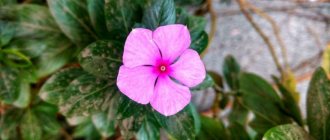Lily in a pot
Caring for a potted lily is not difficult; its agricultural technology is as simple as that of flowers grown in open ground. For tall lilies, pots and flower boxes will be cramped, but if you choose the right variety, these flowers will decorate window sills, balconies and verandas.
Lilies in a pot
Indoor bulbous lily
An indoor lily can be grown to a height of up to 1.5 m, but this is not recommended, since it will be uncomfortable for the flower, and it will require much more care than low-growing varieties. Among them you can also choose spectacular options. People usually pay attention to oriental varieties; for growing at home, they should be given preference over Asian indoor lilies.
For your information! There is another home flower that looks like a lily - amaryllis.
White lily home
When talking about the white house lily, they most often mean eucharis. This is a member of the Amaryllis family. Since this flower grows in the wild in South and Central America, eucharis is often called the Amazon lily. The external signs of the plant are as follows:
- highly decorative bright green leaves;
- height together with peduncles at home reaches 70 cm;
- flowers with a diameter of 10-12 cm, but you can also choose a large-flowered variety;
- flowers are collected in inflorescences;
- the Amazonian variety has a delicate delicate aroma;
- the diameter of the bulbs is 5 cm, the root system is powerful, so the growing pot must be large in diameter;
- With proper care, eucharis blooms twice a year.
Note! The juice of the plant's leaves is poisonous, so it should be kept away from children and pets.
White lily home
Asian indoor lily
The Asian indoor lily is a hybrid developed by plant breeders in the 1950s. It is unpretentious to grow and looks the same at home as it does in open ground. In total there are more than 1500 varieties. The most popular of them are the following:
- Marlene. The height of the plant reaches 1 m, flowering is abundant, occurring in early and mid-summer. The variety has a powerful light green stem, leaves 13-15 cm long. Since the variety is a hybrid, due to some mutations, several dozen buds can form on one stem, but this does not always happen. Sometimes lush flowering begins only in 2-3 years. The flowers reach 20 cm in diameter. The petals are delicate in color, gradually turning pink from the base to the tips;
Variety Lionheart
- Lion Heart. Medium-sized variety. The length of the stem reaches 70 cm. Each stem produces about 10 flowers with a diameter of up to 15 cm. A special feature is its unique color. The petals are bright yellow at the base and tip, and purple, almost black in the middle. The stem and leaves are sprinkled with purple dots;
- Asian terry. A variety of Asiatic lilies that includes many varieties and can be grown both indoors and in the garden. The stems grow up to 1 m in length, the flowers are very large with a diameter of up to 20 cm. The colors vary depending on the variety.
Terry potted lily
Choosing lilies for indoor growing
In rooms you can successfully grow either varieties specially bred for indoor cultivation or compact varieties that hardly produce children. Lilies that grow well indoors include:
- special “potted” varieties of royal lily (Lilium regalum);
- varieties of beautiful lily (Lilium speciosum);
- varieties of long-flowered lily (Lilium longiflorum);
- varieties of golden lily (Lilium auratum);
- potted varieties of the Mid-century group of oriental and Asian hybrids.
It is worth giving preference to dwarf or low-growing varieties (40-60 cm is the optimal height) and the most unpretentious, early varieties. The color scheme is chosen according to taste.
For indoor culture, large (from 40 g), healthy bulbs are used - the best, selected specimens.
Royal lily (Lilium regalum). © meolongxu87
Beautiful lily (Lilium speciosum). © Stefano
Long-flowered lily (Lilium longiflorum). © Nobuhiro Suhara
How long do lilies bloom?
Amazon lily eucharis - home care
Most house lilies bloom in mid-summer, in July. The duration of the flowering period is 2-3 weeks. The plant emerges from dormancy in late February - early March, buds begin to form in late May - early June. In most varieties, at the end of the flowering period, the above-ground part dies off completely, but not in all. For example, eucharis pleases with its foliage all year round, and it blooms twice. Therefore, it is impossible to give an exact answer to the question of how long lilies bloom. Everything is individual and depends only on the type of flower and proper care.
Important! A domestic lily will be able to bloom with bright, lush flowers only if it is given unlimited access to fresh air and bright sunlight. South windows are best suited.
How to plant a lily bulb in a pot
How to plant a lily bulb in a pot? Are there any differences from planting it in open ground? These are the questions that most often concern novice gardeners. Agricultural technology is similar in both cases. But to plant in a pot, you must follow a number of rules.
Planting a house lily bulb in a pot
Lavender in a pot - home care
In order for the bulbous indoor lily to take root, you need to prepare all the necessary material before planting:
- a pot, the height of which for tall plants should be at least 35 cm. To plant one bulb, you will need an area of 15 cm², so more than one bulb can be planted in one large pot;
- properly selected soil. The best option is to purchase a ready-made soil composition designed specifically for these flowers. For those who independently work on the composition of the soil, a mixture of turf and humus in equal parts is suitable;
- drainage;
- planting material, i.e. bulbs.
It is best to plant the bulbs in a pot in early autumn (early September), but you can also do this in the spring. Planting at this time will allow the flower to adapt to new conditions and sprout.
Note! In spring, you should also not delay this; plant it in a pot immediately when the first shoots appear. This could be the end of February, it all depends on the region and storage conditions.
How to grow lilies in a pot from bulbs
To properly grow these flowers at home, you need to start with choosing planting material and the correct planting technology. When selecting material, the following are taken into account:
- quality of material. There should be no rotten, moldy or infected bulbs;
- purity. Each bulb is cleared of the top layer of scales;
- only healthy roots. All flaccid ones are pruned;
- length of the root system. It should not be too long, in which case it must be cut;
- sterility. Each bulb must be treated with an insecticide before planting.
Planting lily bulbs in a pot
How to properly plant a bulb in the soil:
- Cover a third of the pot with pebbles for drainage, then with a layer of soil.
- For each bulb, make a hole twice as deep as the height of the bulb itself.
- Carefully place the planting material into the hole, being careful not to damage the roots.
- Cover with a layer of soil.
- Moisten it with a spray bottle, or with a growth accelerator.
- Mulch well.
How to grow lilies in a pot from seeds
Growing lilies from seeds is not difficult, but it is a little troublesome. Why this method is considered the safest is not difficult to guess, because the seeds definitely do not contain pathogens, rot, mold and other problems that a gardener faces in the process of other types of planting flowers.
Important! Planting can be done immediately after purchasing the seeds, but it is still recommended to carry out a 2-3-week stratification procedure.
It is recommended to sow seeds at the end of March. They will bloom only 2-3 years into the plant’s life. Sowing seeds occurs as standard, the same as for other flowering plants. Seeds are planted in the prepared light soil mixture. Can be planted at a distance of 1 cm. Be sure to put a drainage layer on the bottom of the container. Cover it with glass or film on top, sometimes open it for watering and ventilation. The temperature should be maintained at 20-25°C. The place should be dark. When the first true leaves appear, the flowers are transplanted into separate containers.
What do lily seeds look like?
Preparing lilies for planting
Before planting in a pot, lily bulbs are prepared:
- Carefully remove old dried roots.
- Keep in a pink solution of potassium permanganate for half an hour.
- If desired, soak for 12 hours in a solution of any growth stimulator.
Soil for growing lilies can be purchased at the store. Opt for soil for seedlings with a pH of 6 to 7. It contains useful elements necessary for plants.
You should prepare the soil yourself using humus and turf soil. They are taken in equal proportions and a little ash is added. This mixture will have to be disinfected with a solution of potassium permanganate or Fitosorin.
Caring for lilies at home
Caring for lilies at home is quite simple. You just have to follow a few simple requirements, and the flowering of lilies will delight you with its brightness and splendor. They need to be watered throughout the entire period of active growth: growing season and flowering. The soil should always be moist, but without stagnant moisture. Regular loosening and mulching of the soil is also required; it should not be compacted in order to better allow air to pass through. If there is a need and the flowers are too large, the stem should be tied to a support. Feeding is another necessity during the period of activity. They need to be carried out regularly. Ready-made mineral fertilizers are suitable for this.
Air humidity
Hyacinth in a pot: home care
These plants prefer moist air and like regular spraying. If the air is too dry, you can place a small bowl filled with water next to the flowerpot.
Air temperature
Warm air and plenty of sunlight are preferable. The optimal indoor temperature in summer should be 25 °C.
Lily care during the dormant period
Like plants grown in open ground, indoor lilies, after they have bloomed, need a period of absolute rest. Their ground part dies off, leaving only the bulb.
Important! There is no need to trim the stems. They should dry on their own.
As soon as the flowers have faded and the stems have begun to turn yellow, watering is reduced to once a week. Spraying is stopped completely. After the above-ground part has completely dried out, stop watering the plant altogether. The bulb is dug out of the pot, placed in a bag with moistened sawdust and sent to the refrigerator.
How to feed lilies after flowering
After flowering, you need to continue to care for the plants by feeding them. This will help the bulb store more nutrients, and next year the plants will become even more powerful and bloom even more beautifully. Potassium and phosphorus fertilizers are best suited; they will protect the tubers from diseases and pests, and protect them from fungus.
Containers and substrate
It is not worth planting lilies in separate containers: lilies are placed in a group of 3-6 bulbs, which allows you to quickly fill the substrate with roots and achieve greater decorativeness.
For indoor lilies, choose very large, deep containers with good drainage holes. Pots with a height of 30 cm or more are suitable (the optimal depth is 40 cm or more). The volume of the desired group is calculated based on the diameter: for each lily you need to leave 16-20 cm cube. soil. You can plant 3-4 bulbs in a container with a diameter of about 40 cm.
Lilies can develop normally only in loose, neutral soil, which is a super-nutrient substrate. You can look for a special substrate for lilies, or choose soil for flowering plants, or mix turf soil with compost (or humus) and a portion of complete mineral fertilizers.
To prevent problems with compaction, even to the finished substrate, it is better to additionally add a handful of coarse sand and other loosening additives, for example, perlite. Drainage for lilies is required, with a layer of 5 cm.
If it is not possible to provide additional light to the plants, you can plant lilies for indoor cultivation only from the first ten days of March. When planting by a certain date and shifting the flowering period, it is worth considering that approximately 2.5-3 months will pass from planting to flowering. For winter holidays, lilies are planted in the second half of September, for flowering in May - in the first half of March.
Golden lily (Lilium auratum). © 澎湖小雲雀
Diseases and pests of domestic lilies
Lily is a plant that is prone to various diseases. It is also loved by small insect pests. Fungal infections are another reason for the deterioration of the health of these beautiful flowers.
The leaves are turning yellow
There may be several reasons for yellowing leaves:
- improper care;
- diseases;
- insect pests.
In the first case, the flower may lack moisture. A tropical plant requires regular watering, constant spraying and moist air. If this is not done, the leaves will turn yellow and may fall off. From nutrients, this may result in a lack of iron and phosphorus. To eliminate the cause, you need to select the appropriate fertilizers. But they must be applied carefully, in small doses, so as not to cause further harm.
Possible diseases:
- late blight. This disease occurs when there is too much moisture. To avoid rotting of the bulbs, it is better to remove the plant from the pot, inspect the root system, remove rotting areas and replant in new soil;
- blue mold. In addition to the yellowing of the leaves, the stem also dries out. The reason is the same - excessive watering. The method for solving the problem is similar to the previous one;
- gray rot. It is easy to notice: spots initially appear on the leaves and stem, then they turn yellow. This problem occurs due to excess moisture and too high a temperature.
Note! Among the pests, the lily can be attacked by mole crickets, bugs, ticks and caterpillars. There is only one method of control - treatment with an insecticide.
Why does the indoor lily not bloom?
Most often, indoor lilies do not bloom due to improper care. It is necessary to carefully analyze all indicators in order to eliminate the problem. The soil must be light and have good drainage. Humidity should be kept only at the level necessary to support its development.
Note! Location plays one of the first roles. You cannot leave the lily in the shade; it needs to be moved to a more illuminated place.
How to choose soil?
To grow lilies, it is best to use a substrate made from turf soil and compost or humus. You need to mix in a ratio of 1 to 1. But please note that before planting, the substrate must be spilled with boiling water or a solution of potassium permanganate for disinfection.
To simplify the task, you can use ready-made soil for bulbous plants, which is sold in specialized stores.
How to plant lilies
Many gardeners are wondering when and how to plant lilies so as not to harm them and ensure even more luxuriant flowering. Since daughter tubers periodically appear on the tubers of these plants, at this moment the problem arises of how to plant a lily and replant it correctly.
Transplanting indoor lilies
Varieties whose bulbs are sent to the refrigerator or cellar for the winter are, in any case, replanted annually. But those that constantly grow in one place need to be replanted once every two to three years. A more spacious pot is selected, work is done with the roots: excess, shriveled and rotten parts are cut off.
How to plant lilies in autumn
How to plant a lily in the fall in such a way that no changes occur to it during the winter, and it safely survives the dormant period? Just. Autumn is the optimal time for planting these flowers both in open ground and at home. But it is still worth carrying out this process as carefully as possible. The damaged plant will survive, but will not bloom in the next season.
Note! The lily should bloom and rest a little, only after that its bulb can be dug up and carefully examined, cleaning and removing all damage. Then carefully separate all the daughter bulbs and keep them for half an hour in a weak solution of karbofos or potassium permanganate. Then dig holes that are the size of the separated tubers and transplant them there. Just sprinkle damp soil on top.
When and how to divide lily bulbs
It is believed that the time when lilies can be divided is exclusively spring. But that's not true. You can do this in August - September. The division is very simple: the small children that appear on it are separated from the adult tuber, and they are seated in the same way as adult plants.
Lily originally got its name from the ancient Greek “li-li”, which means “white-white”. But the breeders did their best, and now there are a great variety of colors. An equally pleasant fact is that it is now possible to grow them indoors, and this is not a difficult process at all. In any case, it’s very nice that these flowers can now decorate not only your garden plot, but also your balcony or windowsill.
Indoor lilies after flowering
As the shoots fade and begin to die, you need to proportionally reduce watering and stop feeding. Lilies are not left to overwinter in the substrate. You can remove the bulb from the soil only after the above-ground parts dry out on their own. Children are sure to separate.
During the dormant period, lilies are kept in damp sand, peat or sawdust in a cool room (2-5 degrees Celsius), planted in pots for the next flowering at the desired time. But if they want to alternate varieties or plan to replace them, the bulbs can, if desired, be transferred to open soil in compliance with the rules of open ground agricultural technology.











